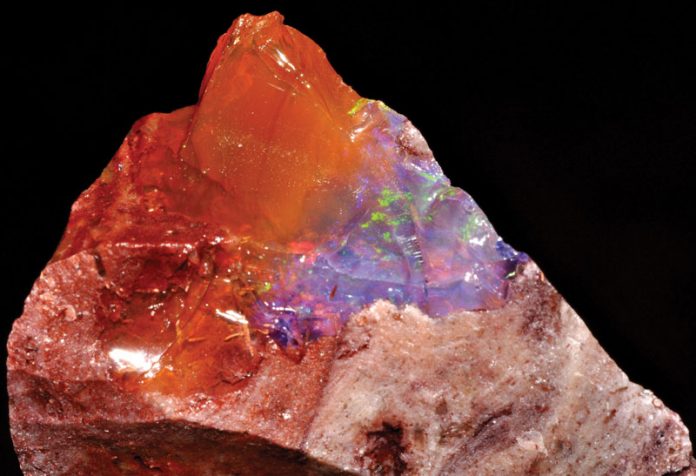
Common opal colors lack the glittering, multicolored opalescence of its precious counterpart, but it is nevertheless a beautiful gemstone with its own unique qualities.
Opal: Precious & Common
Both the common and precious varieties of opal consist of hydrous silicon dioxide.
Despite having a composition similar to that of quartz (silicon dioxide), opal’s properties are much different. Because of its attached molecules of water, opal is substantially softer, more brittle, and less dense than quartz. Most importantly, unlike quartz, common opal does not form crystals, such as druzy gemstones.
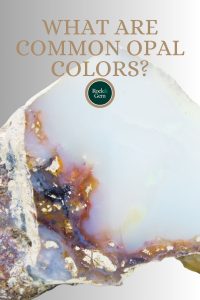
With its amorphous structure and variable chemical composition, all forms of opal are classified as mineraloids—natural, mineral-like materials that do not meet all the qualifications of a mineral. But because opal was historically classified as a mineral, the International Mineralogical Association recognizes tradition and continues to list it as a valid mineral species.
Opalescence Explained
Opal is a solidified, colloidal silica gel with an amorphous structure consisting of randomly arranged, interspersed layers of hydrated silica molecules and microscopic spherules of anhydrous silica. The opalescence of precious opal is created when layers of microscopic silica spherules diffract white light into its component colors. When reflected, these diffracted light waves become reinforced to produce the phenomenon of optical interference and the iridescent colors seen in precious opal.
Common Opal Colors
Common opal either lacks silica spherules or consists of spherules that are too large or too small to create opalescence. Although lacking opalescence, common opal has varying degrees of translucency and scatters light internally to produce a soft, warm glow similar to that of moonstone.
While some common opal is white or colorless, most exhibit a color range caused by traces of accessory elements, usually iron. The colors of common opal include orange-red fire opal, white milky opal, green prase opal, Peruvian pink and blue opal, yellow honey opal, brown wax opal and yellowish-green hyalite.
Non-gem-quality common opal is fairly abundant and occurs as fracture and seam fillings, grain cement in sedimentary rocks and even as opalized wood.
Precious opal is by far the rarest variety of opal, followed by gem-quality common opal.
Fire Opal
The best-known and most valuable type of common opal is fire opal; its rich, orange-red color is caused by microscopic inclusions of hematite. In describing opal colors, “fire” can refer to the opalescence of precious opal or to the orange-red color of common fire opal.
In terms of both quality and quantity, the best fire opal comes from central Mexico.
Because of its unusual degree of transparency, Mexican fire opal is usually faceted, while all other types of common opal are cut as cabochons. Mexican fire opal occasionally exhibits subtle flashes of greenish-yellow opalescence because of partially formed, silica-spherule layers that diffract and reflect only part of the incident light.
Hyalite
The only truly transparent common opal is hyalite, in which subtle hints of greenish-yellow are caused by traces of iron.
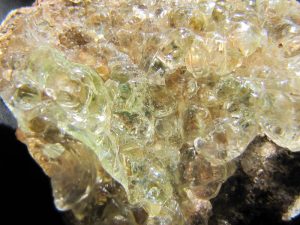 Hyalite also exhibits the rare phenomenon of “daylight fluorescence” which occurs when sunlight energizes electrons within the opal. These electrons then release excess energy as visible, greenish-yellow light. The combination of daylight fluorescence and hyalite’s base color produces a particularly pure and lively greenish-yellow hue. Hyalite’s daylight fluorescence and its strong, ultraviolet fluorescence are because of traces of the radioactive element uranium.
Hyalite also exhibits the rare phenomenon of “daylight fluorescence” which occurs when sunlight energizes electrons within the opal. These electrons then release excess energy as visible, greenish-yellow light. The combination of daylight fluorescence and hyalite’s base color produces a particularly pure and lively greenish-yellow hue. Hyalite’s daylight fluorescence and its strong, ultraviolet fluorescence are because of traces of the radioactive element uranium.
While most opal solidifies directly from silica gel, hyalite forms when silica-laden gases emitted by rhyolitic magma condense into silica gel that subsequently solidifies into botryoidal masses. Although hyalite rarely occurs in sizes large enough to facet, botryoidal free forms are often wire-wrapped and worn as pendants.
Opal from Peru: Pink & Blue
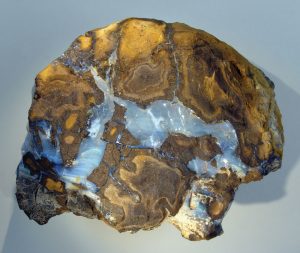
Wikimedia Commons
Peruvian pink opal, a rare example of organic coloration in gemstones, consists of a mixture of hydrated silica, chalcedony, and palygorskite, the latter a complex hydrous magnesium aluminum silicate. Palygorskite’s fibrous crystals have a strong affinity for organic molecules.
The pigments in Peruvian pink opal are reddish-colored quinones, hydrocarbon compounds that originated as ancient plant materials in a now-buried lake bottom within a basaltic environment. With an abundant supply of magnesium from the basalt, palygorskite formed, attached quinone molecules and became part of the silica gel that solidified into Peruvian pink opal.
Peruvian blue opal, characterized by its blue-to-blue-green color and soft translucency, comes from an old copper-mining district in southern Peru. Its unusual color is produced by microscopic inclusions of the copper-bearing mineral chrysocolla.
Other Common Opal Colors
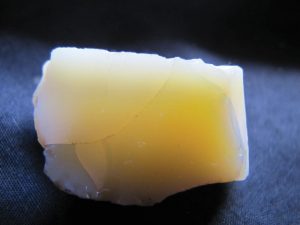
Milky opal, not to be confused with white precious opal, is the most abundant type of gem-quality common opal. It has an off-white color, a moonstone-like translucency, and a warm glow caused by the internal scattering of light. The presence of iron often produces soft, bluish or orange undertones. Milky opal is fashioned into beads and cabochons.
Prase opal’s distinctive, chrysoprase-like green color is caused by a nickel chromophore. The dark, spiderweb-like patterns of dendritic opal are created when black manganese oxides fill tiny fractures in the crazed (fractured) opal surface. Multicolored, banded opal, which has only limited translucency, forms from variations in the chemical composition of silica gel during the solidification process.
So while precious opal may always rule the roost in the opal hierarchy, common opal is nevertheless a fine and distinctive gemstone—even without opalescence.
This story about common opal colors appeared in Rock & Gem magazine. Click here to subscribe. Story by Steve Voynick.















